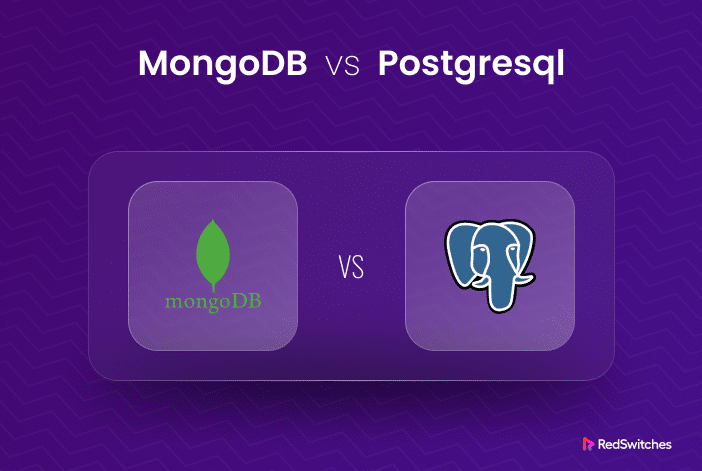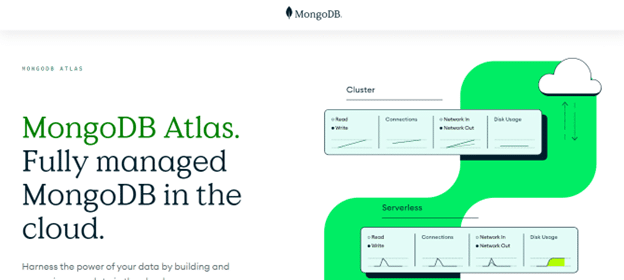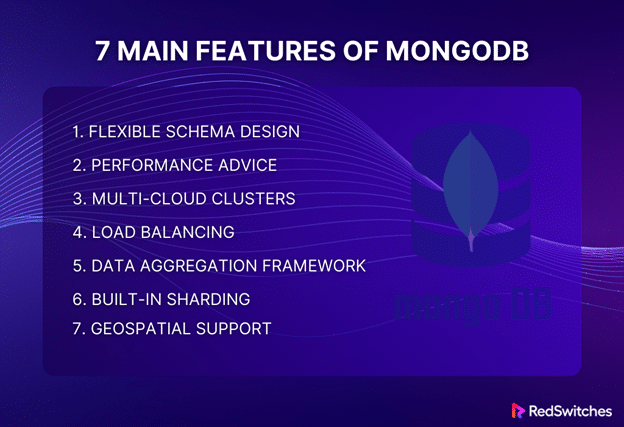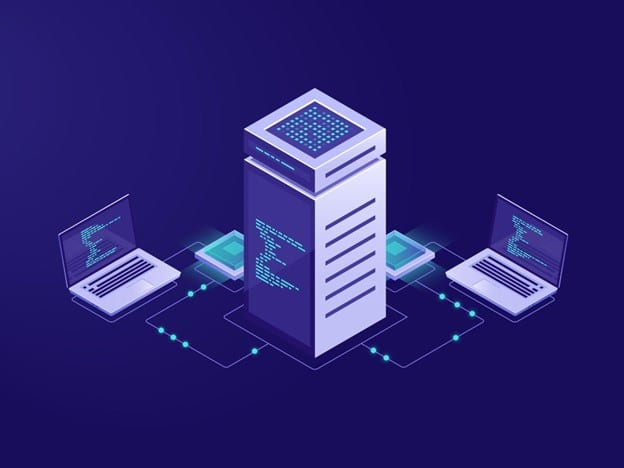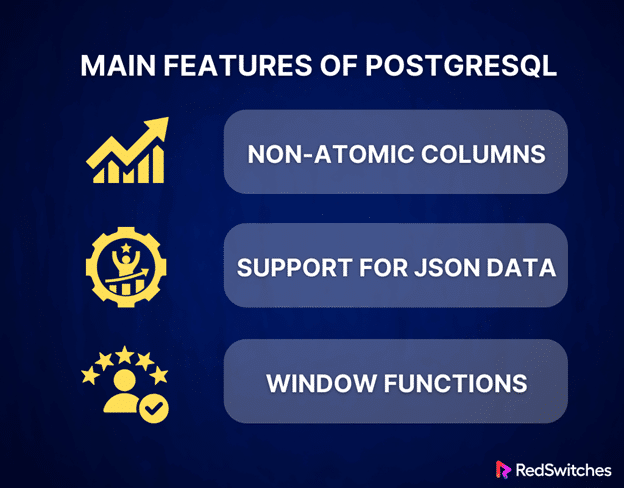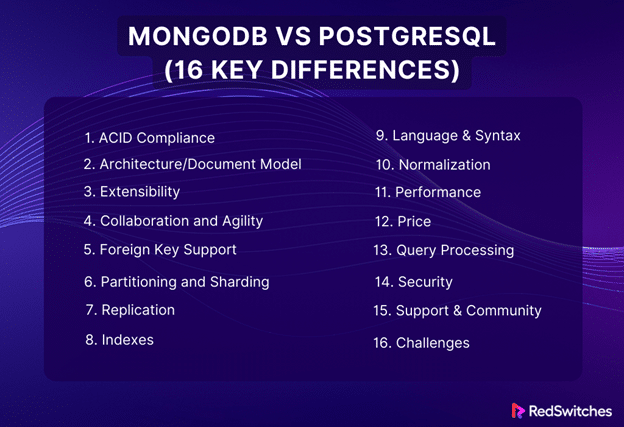In the vast realm of database technologies, two titans have emerged, capturing the attention of developers and businesses alike: MongoDB and PostgreSQL. One, a symbol of the NoSQL revolution, challenges traditional norms with its flexible schema and document-centric model. The other, a stalwart of relational database systems, boasts decades of reliability, intricate query capabilities, and steadfast data integrity.
As the digital world continues its relentless expansion, choosing between these two powerhouses has become a pivotal decision for many. In exploring Mongodb vs postgresql, we dive deep into both systems’ intricacies, strengths, and weaknesses.
Prepare to embark on a journey that will illuminate the nuanced differences and help determine which database champion suits your needs.
Table of Contents
- What Is MongoDB?
- What Is PostgreSQL?
- MongoDB vs PostgreSQL: 16 Key Differences
- When to Use MongoDB vs PostgreSQL?
- Conclusion
- FAQs
What Is MongoDB?
MongoDB, first introduced to the world on February 11, 2009, stands as a shining beacon in the domain of non-relational databases.
This cross-platform, open-source database is renowned for using JSON-like documents, allowing data storage without the constraints of a fixed schema. It’s not just its structure that makes MongoDB compelling. The advanced cloud capabilities of MongoDB, offering unparalleled data distribution across major platforms like Azure, AWS, and Google Cloud, underscore its dominance in the modern database market.
Credit: MongoDB
One of MongoDB’s notable offerings, MongoDB Atlas, empowers users to swiftly set up cloud databases, ensuring applications remain agile and responsive. As you scale and integrate new features, Atlas provides a suite of optimization tools, ensuring you have the resources to keep building and innovating.
Interested in getting hands-on with MongoDB? Check out our comprehensive guide: The Ultimate Guide to Installing MongoDB on Ubuntu. Equip yourself with step-by-step instructions and tips to ensure a smooth installation experience.
Main Features
The following are the main features of MongoDB:
- Flexible Schema Design:
- Description: Unlike traditional relational databases that require a fixed schema, MongoDB offers flexibility in data storage with its dynamic schema. This means you can modify your documents’ structure without modifying the entire collection.
- Benefits: This flexibility is particularly advantageous during the development phase of applications, as changes and iterations can be made without extensive database refactoring.
- Performance Advice:
- Description: MongoDB doesn’t leave you to navigate the waters of performance optimization alone. It offers proactive suggestions on designing your schema based on your application’s evolving needs.
- Benefits: This ensures that your application remains optimized for speed and efficiency, even as data structures and access patterns change.
- Multi-Cloud Clusters:
- Description: MongoDB’s ability to span multiple cloud providers means that your application can harness the strengths of Azure, AWS, Google Cloud, and others simultaneously.
- Benefits: This multi-cloud capability leads to enhanced resilience, as you’re not putting all your eggs in one basket, and can lead to cost savings by leveraging the best pricing from multiple providers.
- Load Balancing:
- Description: MongoDB manages traffic with its efficient load balancing. Distributing client requests across several servers ensures no single server becomes a bottleneck.
- Benefits: This results in consistent application performance, better resource utilization, and improved data availability, especially vital for applications with high concurrent user loads.
- Data Aggregation Framework:
- Description: MongoDB has a powerful aggregation framework that allows complex data transformations and computations, enabling you to process data and derive insights.
- Benefits: This is especially useful for analytics and data processing tasks, providing a robust solution without needing external processing tools.
- Built-in Sharding:
- Description: MongoDB can distribute data across multiple servers using sharding as data grows. This ensures that your database scales horizontally.
- Benefits: Sharding allows for efficient data distribution, faster write/read operations, and improved application responsiveness as data grows.
- Geospatial Support:
- Description: MongoDB offers built-in support for geospatial data storage and queries. This makes it ideal for location-based services and applications.
- Benefits: Whether you’re building a delivery application, real estate platform, or any other service that relies on location data, MongoDB provides the tools to store, process, and query geospatial information efficiently.
Use Cases
MongoDB isn’t just a database; it’s a solution many organizations adopt for diverse applications.
Content Management:
Looking to weave various data types, features, and content into one cohesive structure? MongoDB is your ally. It empowers teams to build content-rich applications at a fraction of the expected cost without compromising capabilities.
Payments:
Whether you’re a startup eyeing the next disruptive payment solution or an established enterprise aiming to rejuvenate its payment systems, MongoDB offers unmatched data agility. With it, you can build products rapidly and harness existing data, bypassing the pitfalls of generic, high-risk solutions.
Personalization:
MongoDB allows businesses to tailor experiences for millions in an era where customization is king. MongoDB makes real-time personalization a breeze, whether targeted promotions, user-specific dashboards, or seamless social media integrations. And the best part? Running intricate queries on your data doesn’t necessitate cumbersome processes.
Mainframe Offloading:
The agility of MongoDB extends to mainframe offloading. Businesses can redirect operations and alleviate the strain on mainframes by replicating frequently accessed mainframe data to MongoDB’s operational data layer.
Credit: Freepik
What Is PostgreSQL?
Even as NoSQL databases capture attention flexibly, relational databases remain indispensable in data storage. Their strength in running intricate queries and a penchant for data-based reporting make them preferred when the data structure remains relatively consistent. Amongst these, PostgreSQL stands tall as a potent, open-source alternative to its licensed brethren like SQL Server and Oracle.
Boasting a rich history spanning over two decades, PostgreSQL’s journey is a testament to consistent community development efforts. These have endowed it with unparalleled integrity, resilience, and correctness.
Whether serving as the backbone for web applications or the central warehouse for vast data reservoirs, PostgreSQL’s capabilities are expansive. Couple this with the absence of licensing costs and a dedicated community vigilantly safeguarding its security, and you have a database system that’s hard to rival.
Main Features of PostgreSQL
The following are the main features of PostgreSQL:
- Non-Atomic Columns:
- Description: While traditional relational models dictate atomicity in columns, PostgreSQL ventures beyond. It allows columns to have sub-values, which can be effortlessly accessed and queried.
- Benefits: This flexibility paves the way for more complex data structures within a relational model, enhancing data representation.
- Support for JSON Data:
- Description: PostgreSQL seamlessly integrates capabilities to query and store JSON data, enabling it to handle NoSQL workloads. This is invaluable when dealing with continually evolving or unstructured data.
- Benefits: Such versatility means you can design databases for varied needs, like sensor data, without being constrained by fixed columns.
- Window Functions:
- Description: A shining gem in PostgreSQL’s feature set, window functions facilitate executing functions over several rows, retaining the original row count. This is distinct from aggregate functions, which consolidate rows into a single output.
- Benefits: These functions are indispensable for analytical applications, enabling complex computations across data sets without losing granularity.
Use Cases for PostgreSQL
From intricate scientific data to the backbone of modern web applications, PostgreSQL showcases its prowess in a multitude of scenarios:
- Federated Hub Database:
With its JSON support and foreign data wrappers adeptness, PostgreSQL can seamlessly interlink with various data stores, including NoSQL databases. This positions PostgreSQL as a central federated hub, streamlining interactions in multi-database ecosystems.
- Scientific Data Processing:
The vast data deluge from scientific and research endeavors requires meticulous management. PostgreSQL’s robust SQL engine and analytical prowess emerge as the go-to solution. Swift, accurate processing of data terabytes ensures research projects remain agile and insightful.
- Manufacturing:
Several leading industrial manufacturers harness PostgreSQL’s capabilities. From customer-centric operations to supply chain optimization, PostgreSQL serves as a reliable storage backend. Accelerated innovation, enhanced growth, and refined processes are all anchored by a robust database system.
- LAPP Open-Source Stack:
PostgreSQL is an integral component of the LAPP stack, an alternative to the popular LAMP stack. PostgreSQL uses Linux, Apache, Python, PHP, and Perl to power dynamic web applications.
A resilient, open-source ecosystem for modern web applications, ensuring performance, security, and scalability. If you’re leaning towards PostgreSQL after weighing its pros and cons against MongoDB, ensuring you’re getting the most out of your database setup is crucial.
Dive deeper into optimizing PostgreSQL with our detailed blog: The Postgres Best Practices For Improved Database Performance and Security. Discover expert insights and advanced techniques to improve database performance and safeguard data. Don’t miss out!
As we navigate the digital landscape of database technologies, MongoDB and PostgreSQL stand tall, each heralded for their unique strengths. Yet, when pitted against each other, the distinctions aren’t always clear-cut. Delve deeper with us as we illuminate the 16 pivotal differences between these two database giants, offering insights to guide your technological choices.
MongoDB vs PostgreSQL: 16 Key Differences
ACID Compliance
In database management, ACID compliance is a critical standard, ensuring the reliability of transactions in a database system. When evaluating MongoDB vs PostgreSQL, it’s essential to understand their respective approaches to ACID properties.
PostgreSQL’s Approach:
Transactional Integrity:
- At its core, PostgreSQL uses the read committed isolation level as its default. However, it offers the flexibility to adjust this, reaching up to the serializable isolation level.
- This adaptability underscores the database’s commitment to transactional security.
Grouped Changes:
- A distinctive feature of relational databases like PostgreSQL is their ability to group various changes.
- These can either be executed or rolled back collectively, showcasing the interconnected nature of data in parent-child table relationships.
MongoDB’s Perspective:
Document-Centric Approach:
- MongoDB vs PostgreSQL performance in transaction execution varies. MongoDB, a document database, inherently has atomic read and write operations for single documents.
- This nature eradicates the need for multi-document transactions in many scenarios.
Total Isolation:
- During updates, MongoDB ensures complete document isolation.
- Should any hiccup occur, the system will revert the change, maintaining the document’s consistent view for clients.
Multi-Document Transactions:
- Unique to MongoDB, it supports transactions spanning multiple documents.
- This feature, combined with its document-centric design, positions MongoDB uniquely.
- It manages to fuse the agility and speed of the document model with the robust ACID guarantees typical of traditional databases.
Navigating the nuances of MongoDB vs PostgreSQL, one discerns that both platforms bring formidable features, tailoring their ACID compliance approaches to their foundational database structures.
Credit: Pexels
Whether you’re using MongoDB, PostgreSQL, or any other database system, the performance of your database relies heavily on the infrastructure it runs on. Explore our Dedicated Server Hosting solutions at RedSwitches, tailored to ensure optimal performance, reliability, and scalability for your applications.
Architecture/Document Model
Understanding the underlying architecture is fundamental in the continuously evolving landscape of databases. When juxtaposing MongoDB vs PostgreSQL, it becomes evident that their architectural distinctions pivot on their document and relational models, respectively.
MongoDB’s Document-Centric Approach:
Natural Object Mapping:
- MongoDB’s document model seamlessly maps to objects within application code, simplifying the curve for full-stack developers.
Binary JSON (BSON):
- Documents are stored in BSON, a binary representation, enabling quick query access through MongoDB’s versatile query language.
Flexible Structure:
- Unlike conventional databases, MongoDB’s documents are self-describing.
- Adding new fields doesn’t necessitate altering other documents or updating overarching system catalogs.
Schema Validation:
- MongoDB emphasizes flexibility but doesn’t forsake data governance.
- You can enforce schema validation on collections, aiding in data consistency, especially when integrating diverse data sources or adapting to evolving application requirements.
PostgreSQL’s Client-Server Model:
Client-Side Process:
- Serving as the user interface, this process facilitates user interactions with the database via APIs, bridging the gap between users and data.
Server-Side Process:
- The heart of PostgreSQL is governed by the ‘Postmaster’, a pivotal coordinator ensuring the smooth running of the PostgreSQL environment. The Postmaster’s tasks encompass
- Recovery operations.
- Initializing and shutting down the server.
- Orchestrating background tasks.
- Handling incoming client connection requests.
Evaluating MongoDB vs PostgreSQL speed and overall functionality, one can appreciate that each is tailored to distinct needs, driven by their inherent architectural foundations. Whether you’re focused on a flexible document-centric model or a robust relational approach will steer your choice between these two database giants.
Considering PostgreSQL for your database needs? Setting up can be seamless! Before you get started, check out our definitive guide: A Comprehensive Guide to Installing PostgreSQL on CentOS: Step-by-Step Instructions. Equip yourself with the essential steps and expert tips to ensure a smooth and successful installation process. Dive in now for a hassle-free setup!
Extensibility
The realm of databases is vast, and extensibility is a critical determinant when considering MongoDB vs PostgreSQL. Extensibility is a system’s inherent capacity to embrace new functionalities or capabilities without compromising its core structure or performance.
PostgreSQL’s Multifaceted Extensibility:
Catalog-Driven Operations:
- Its catalog-driven design is Central to PostgreSQL’s extensibility.
- Unlike conventional databases, PostgreSQL leans on system catalogs that function as data dictionaries containing intricate details about tables, columns, data types, and more.
Dynamic Loading:
- PostgreSQL offers a dynamic loading feature tailored to unique needs.
- If users necessitate distinct functionalities, they can embed shared libraries.
- Once specified, PostgreSQL effortlessly loads the code, making it an ideal choice for swift application prototyping.
MongoDB’s Modernized Extensibility:
User-Defined Functions (UDF):
- MongoDB has evolved to incorporate a level of extensibility mirroring relational databases. Users can now craft their functions, integrating them seamlessly within MongoDB’s framework. This approach resonates with the UDFs in relational databases like PostgreSQL, enhancing SQL statements.
Unified Extensions:
- While comparing the performance of MongoDB vs PostgreSQL, it’s essential to note that both support an array of extensions and plugins.
- Tools like Adminer augment database management, underlining the extensibility strengths of MongoDB and PostgreSQL.
As the digital landscape broadens, the extensibility of database systems will only gain prominence, making this facet vital when choosing between MongoDB vs PostgreSQL.
Collaboration and Agility
In the constantly evolving technological landscape, collaboration and agility are fundamental pillars. The distinctions become discernibly significant when evaluating MongoDB vs PostgreSQL on these grounds.
MongoDB: The Epitome of Agility:
Document-Based Model:
- MongoDB, with its document-centric model, accelerates collaborative processes, offering a seamless developmental experience.
- Leveraging JSON or BSON to archive its data, MongoDB ensures rapid and efficient operations.
BSON’s Efficiency:
- Unlike JSON’s generic data handling, BSON offers specialized data types like DateTime, long, and byte array.
- This specificity streamlines queries, bolstering the MongoDB speed vs PostgreSQL.
Flexibility and Development:
- MongoDB’s inherent design permits users to redefine structures, incorporate new fields, or modify data effortlessly.
- This dynamic nature negates potential delays often associated with traditional restructuring processes.
Seamless Team Collaboration: With its user-centric approach, MongoDB eradicates the need for intricate communications between development teams.
PostgreSQL: Structured Collaboration:
Granular Privileges:
- PostgreSQL’s collaboration strengths lie in its meticulous privilege management.
- Users can be granted specific read and write privileges, enhancing security and collaboration.
Auditing Capabilities: PostgreSQL extends an auditing feature, enabling administrators to monitor and review data access activities of different user groups, ensuring elevated security.
Though both databases excel in collaboration, the agility factor tilts the balance, with MongoDB standing a notch above PostgreSQL due to its non-relational structure and inherent flexibility. Yet, one’s choice should align with specific requirements and the nature of the project.
Curious about the broader landscape of NoSQL databases, of which MongoDB is a part? Dive into our in-depth article: A Comprehensive Guide to NoSQL Databases: Features, Advantages, and Types. Expand your understanding and discover the full potential and diversity of NoSQL databases. Perfect for those looking to make informed decisions in the ever-evolving world of database management!
Foreign Key Support
Foreign critical support plays a pivotal role in data management, especially when comparing MongoDB vs PostgreSQL. The core distinction emerges from their inherent design philosophies and how they manage relational data.
Credit: Pexels
MongoDB: Navigating Beyond Traditional Keys:
Non-Relational Structure: MongoDB’s schema-less design ditches tables for collections, making the traditional notion of foreign keys irrelevant.
Lack of Foreign Key Constraints: Without tables, MongoDB neither supports foreign keys nor their constraints, favoring flexibility over strict relational connections.
DBRef Standard: Despite the absence of foreign keys, MongoDB introduces DBRef, a mechanism to create references between collections, providing a semblance of relational connectivity.
PostgreSQL: Upholding SQL Standards:
SQL-Compliance: Being a relational database, PostgreSQL meticulously adheres to SQL standards, including robust support for foreign keys.
Foreign Key Constraints:
- PostgreSQL accentuates the importance of data integrity.
- Leveraging foreign key constraints restricts the insertion of mismatched data, ensuring consistency and maintaining relationships between tables.
In conclusion, while PostgreSQL performance vs MongoDB regarding data integrity and strict relational links is commendable, MongoDB offers more flexibility. The choice between the two should be guided by the project’s needs – whether strict relational data integrity or flexible schema-less design is the priority.
While MongoDB and PostgreSQL have their merits, the underlying performance of mongodb vs postgresql can make all the difference in database operations.
If you’re serious about maximizing your database’s potential, consider hosting it on a reliable, high-performance platform. Check out Bare Metal Servers for top-tier hosting solutions that ensure your databases run at their peak efficiency. Perfect for businesses prioritizing performance and reliability.
Partitioning and Sharding
Partitioning and sharding, two pivotal techniques in data management, ensure efficient storage and quick retrieval. Their deployment varies significantly when contrasting MongoDB vs PostgreSQL, and understanding this distinction is paramount for effective database management.
MongoDB: Mastering Data Distribution:
Document-Centric Approach: Given its non-relational design, MongoDB deals with data as independent documents, which eases their distribution across servers without fragmenting the data.
Scalability via Sharding:
- MongoDB can partition data over multiple server instances within a cluster.
- This horizontal scaling, known as sharding, ensures efficient load distribution and high availability.
MongoDB Atlas: Offering a cloud service solution, MongoDB Atlas enables data distribution across diverse regions, either specific or global, ensuring data proximity and reduced latency.
Live Resharding: With the advent of version 5.0, MongoDB introduced a “live” resharding feature, a significant enhancement that facilitates automatic data redistribution based on set policies.
PostgreSQL: Harnessing Declarative Partitioning:
Structured Partitioning: PostgreSQL’s relational model thrives on structured data. Its approach to partitioning revolves around dividing a table, termed the ‘partitioned table’, based on predefined criteria.
Range Partitioning: PostgreSQL supports partitioning by ranges, whereby tables are split based on defined value ranges without overlap.
List Partitioning: PostgreSQL also allows list partitioning, partitioning the data per specified key values, ensuring structured and systematic data storage.
In summary, while MongoDB capitalizes on sharding and partitioning to enhance scalability and manageability, PostgreSQL focuses on declarative partitioning to uphold data integrity and order. The choice between MongoDB vs PostgreSQL hinges on whether the preference is for flexible data distribution or structured data storage.
Credit: Freepik
Replication
Replication, a fundamental concept in database management, ensures data redundancy and high availability. Creating copies of datasets across multiple servers protects against unforeseen challenges like server failures or maintenance downtimes. Delving into MongoDB vs PostgreSQL, we discover unique replication techniques tailored to each database’s architecture and requirements.
MongoDB: Reliability through Replica Sets:
Replica Set Configuration:
- MongoDB’s approach to replication revolves around “replica sets.”
- This setup consists of a primary node and several secondary nodes continuously synchronizing data.
- Any modifications made to the primary are replicated across the secondary nodes, ensuring real-time data consistency.
High Fault Tolerance: In the event of primary server failure or scheduled maintenance, one of the secondary nodes can be promptly promoted to a primary role, ensuring uninterrupted database operations.
Geographical Redundancy:
- With MongoDB Atlas, administrators can deploy replica sets across various data centers.
- This geographic redundancy safeguards against regional outages, providing data protection.
PostgreSQL: Diverse Replication Mechanisms:
Primary-Secondary Replication:
- PostgreSQL’s fundamental replication model is primary-secondary.
- This entails a primary (master) server responsible for handling write operations and one or more secondary (slave) servers that handle read operations.
Write-Ahead Logs (WAL): Vital to PostgreSQL’s replication strategy, WAL logs changes made in the primary database. These logs are then shared with the secondary nodes, facilitating asynchronous replication.
Rich Replication Options:
Beyond the primary-secondary model, PostgreSQL supports many replication methods:
- Streaming Replication: Enables real-time WAL records transfer to maintain database replicas in sync.
- Logical Replication: Offers more granularity by allowing table-level data replication.
- Physical Replication: Directly replicates database files, ensuring byte-to-byte copying.
In essence, while MongoDB banks on the robustness of replica sets for redundancy, PostgreSQL provides a versatile array of replication methods catering to various use cases. In the debate between MongoDB vs PostgreSQL, the choice hinges on the specific replication requirements and system architecture preferences.
Interested in diving deeper into the world of databases? Check out our comprehensive guide: An Introduction To Database: Types, Understanding DBMS & More. Gain a foundational understanding of databases and expand your knowledge beyond just MongoDB and PostgreSQL. Perfect for both beginners and experts alike!
Indexes
Indexes, pivotal structures in postgresql and mongodb, serve as the cornerstones for efficient data retrieval. The debate between MongoDB vs PostgreSQL highlights each system’s distinct indexing approach, aiming for rapid data access and optimal performance.
PostgreSQL: Diversity in Index Types:
Traditional Indexing:
- B-tree: Default and most commonly used index type suitable for sorting and range queries.
- Multicolumn: Efficiently indexes multiple columns as a single combined entry.
- Expression Indexes: Tailored for indexing the result of an expression or function.
Advanced Indexing Techniques:
- GiST (Generalized Search Tree): A balanced tree structure supporting various search modes.
- KNN GiST: Enables k-nearest neighbor searches.
- SP-GiST (Space-partitioned Generalized Search Tree): Deals with data that can be partitioned into non-overlapping regions.
- GIN (Generalized Inverted Index): Efficient for indexing composite values.
- BRIN (Block Range INdexes): Suitable for large tables with a natural sort order.
- Covering Indexes: Stores additional non-key columns along with the index.
- Bloom Filters: Probabilistic data structures for membership queries.
MongoDB: Flexibility in Data Structures:
General Indexing: MongoDB’s default index type is B-tree, similar to PostgreSQL.
Subdocument and Array Indexing: MongoDB’s strength lies in its capability to index nested subdocuments and arrays, ensuring rapid access even if the data is deeply embedded. Such flexibility is inherent to MongoDB’s document model.
Compound Indexes: Like multicolumn indexes in PostgreSQL, MongoDB allows indexing multiple fields within a single collection.
Specialized Indexes: MongoDB also supports a range of specific indexes such as geospatial, hashed, wildcard, and text indexes tailored to various use cases.
In conclusion, MongoDB and PostgreSQL offer a robust suite of index types, albeit tailored to their respective data models. While PostgreSQL boasts a myriad of advanced indexing techniques, MongoDB stands out with its flexible approach to indexing varying data structures. The choice between the two hinges on the application’s specific data storage and retrieval requirements.
Credit: Freepik
Language & Syntax
The interplay of MongoDB vs PostgreSQL is a fascinating juxtaposition, particularly when delving into language support and syntax differences. Each system’s unique support for diverse languages and its proprietary syntax demonstrate its adaptability and potential for integrating into varied tech stacks.
MongoDB: Versatility Across Modern Languages:
Driver Support: MongoDB has developed a suite of drivers tailored for popular programming languages. These drivers serve as the interface between the application and the database.
Prominent Languages Supported:
- Python: Popular for data science and web development projects.
- Java and Scala: Favored by enterprise applications.
- js: Ideal for real-time, scalable applications.
- C, C++, C#: Broad application from system programming to game development.
- Others like R, which is essential for statistical computing.
Syntax: MongoDB uses JSON-like documents, and queries are expressed as documents. It makes the data structure more intuitive, especially for developers familiar with JSON.
PostgreSQL: Embracing Procedural Languages:
Procedural Language Support: PostgreSQL is well-regarded for its extensible support for various procedural languages.
Core Procedural Languages:
- PL/pgSQL: SQL procedural language that extends SQL by adding control structures.
- PL/Python, PL/Perl, PL/Tcl: Enabling developers to write database procedures in Python, Perl, and Tcl, respectively.
External Extensions:
- PL/Java: Supports stored procedures written in Java.
- PL/PHP: For procedures in PHP.
- PL/Ruby: Enables Ruby-based database scripting.
- Syntax: PostgreSQL uses SQL for querying, a standard language for database operations. Its syntax is well-structured, making it easier for those who understand relational database systems.
MongoDB and PostgreSQL cater to a broad spectrum of developers through their language support, allowing seamless integration into diverse ecosystems. While MongoDB resonates more with the modern application developer due to its JSON-like syntax, PostgreSQL’s SQL-based structure and extensive procedural language support make it a favorite for traditional database enthusiasts and developers who prefer more control over database operations.
Normalization
When discussing databases, the conversation often concerns data structure and organization. One pivotal concept that stands out is “normalization.” This process is integral to designing and managing relational databases, ensuring minimal redundancy, high data integrity, and smooth data modification processes.
In the discourse of MongoDB vs PostgreSQL, each system exhibits a unique handling of normalization, and thus, it’s essential to understand these differences.
MongoDB and Normalization:
MongoDB, being a NoSQL database, provides a flexible approach to data structuring.
Denormalized (Embedded) Data Models: In MongoDB, embedded or denormalized data models allow applications to store related data sets within the same document. This design ensures
- Performance Boost: Enhanced read operation performance.
- Efficiency: Retrieval of related data in just one database operation.
- Atomic Write Operations: The ability to update related data in one go.
However, it’s essential to remember that for this model, individual documents in MongoDB must not exceed the maximum BSON document size of 16 MB.
Normalized Data Models: MongoDB can also support normalized data models where relationships between data are described using references between documents.
This model is especially valuable when the disadvantages of embedding, such as data duplication, outweigh the performance benefits.
Memory Consumption: A significant downside to the denormalization process in MongoDB is the potential for high memory consumption. When normalized data is grouped (or denormalized) to boost performance, it can significantly increase memory usage.
PostgreSQL and Normalization:
PostgreSQL, a relational database system, traditionally emphasizes normalization.
Defined Schemas with Identified Relationships: In PostgreSQL, schemas are strictly defined, with data relationships being identified. These relationships can be of various types:
- 1:1 (One-to-One)
- 1:many (One-to-Many)
- many:1 (Many-to-One)
Benefits of Normalization in PostgreSQL: The structured approach of PostgreSQL ensures that data redundancy is minimized by eliminating duplicate data. This naturally enhances data integrity. As a result, any alterations in the database maintain a higher level of consistency and accuracy.
PostgreSQL Performance vs MongoDB:
When comparing PostgreSQL performance vs MongoDB in the context of normalization, several factors come into play:
Read/Write Operations: MongoDB’s denormalized approach can often lead to faster read operations due to its embedded data models. However, PostgreSQL might have the edge in complex transactional operations due to its relational nature and structured query capabilities.
Scalability: MongoDB might offer more straightforward horizontal scalability, whereas PostgreSQL’s strength lies in its vertical scalability.
Data Integrity: PostgreSQL, with its strict schemas and emphasis on normalization, may offer a higher data integrity guarantee than MongoDB.
In conclusion, when choosing between MongoDB and PostgreSQL, it’s essential to consider the specific needs of your application, the nature of your data, and the desired performance metrics. Both databases have their strengths and trade-offs regarding normalization and performance.
Credit: Freepik
Performance
Understanding the performance intricacies of database management systems is fundamental when oscillating between choices. The comparison of MongoDB vs PostgreSQL reveals how each system addresses performance, armed with its unique architecture and design philosophy. Here, we’ll delve deep into their respective attributes.
MongoDB: Built for Scalability and Quick Execution
Horizontal Scaling: MongoDB’s foundational design leans towards scaling out, allowing it to distribute data processing over numerous devices. Especially adept at supporting large-scale applications, whether assessed in terms of data volume or user count. Has the architectural prowess to assimilate hundreds of machines to cater to extensive applications.
Fast Query Execution: Tailored to swiftly execute queries, even when grappling with substantial data volumes. Features like hedged reads from MongoDB 4.4 enhance performance, directing queries to multiple replica set nodes and harnessing the fastest response.
Transition to ACID Transactions: Version 4.0 saw the introduction of ACID transactions, mirroring the transactional reliability of traditional SQL databases.
PostgreSQL: ACID Compliance Paired with Advanced Optimizations
Stellar ACID Compliance: While it may not champion raw data insertion speed, it excels in ACID compliance, ensuring transactions are processed safely and consistently.
Prioritizes the integrity of transactions, choosing to abort an operation entirely rather than risking partial execution.
The strategy of Vertical Scaling: Unlike MongoDB’s horizontal stance, PostgreSQL embarks on a vertical scaling route, enhancing an existing database node with improved hardware.
Performance Enhancement Techniques: Houses a seasoned query planner that refines query executions. Incorporates Just-In-Time (JIT) Compilation, optimizing the real-time processing of expressions.
Uses table partitioning for data management and read query parallelization to bolster read performance.
Mongodb vs Postgresql performance isn’t a straightforward verdict. While MongoDB potentially surpasses PostgreSQL in data insertion speeds and horizontal scalability, PostgreSQL stands tall with its unwavering commitment to ACID compliance and myriad performance optimizations. Your preference between the two should resonate with the application’s requirements and performance expectations. Both are powerful contenders and recognizing their individual strengths will lead to a well-informed decision.
Price
Cost remains a critical factor for many organizations and individuals when considering adopting a database management system. Here, we dive into MongoDB vs PostgreSQL’s price dynamics to provide a clearer picture.
PostgreSQL: Truly Open-Source and Free
Absolute Open-Source Freedom: PostgreSQL is an open-source system, making it free for anyone to use, adapt, and even modify the source code.
It encourages a community-driven approach, with developers worldwide contributing to its ever-evolving features.
MongoDB: A Blend of Free and Paid Offerings
Core Open-Source Version: MongoDB’s core version is open-source and can be freely accessed and modified by developers, fostering community collaboration.
Enterprise & Cloud Options:
- MongoDB Enterprise: An on-premise option tailored for businesses needing a more robust feature set, with its own pricing model.
- MongoDB Atlas: Cloud-hosted MongoDB with various pricing structures based on usage, ensuring flexibility and scalability.
Serverless: Starting at $0.10/million reads. Suited for serverless applications with unpredictable traffic. Features include:
- Up to 1TB storage.
- Automatic resource scaling.
- Pay-as-you-go model.
- Constant security and backup.
Dedicated: Starting at $57/month. Designed for production-level applications with sophisticated demands. Features include
- 10GB to 4TB storage range.
- 2GB to 768GB RAM.
- Enhanced network security and access controls.
- Options for multi-region and multi-cloud deployments.
Shared: Free version. Ideal for newcomers and those keen to explore MongoDB in a cloud setting. Features include
- 512MB to 5GB of storage.
- Shared RAM with options to upgrade.
- No initial credit card requirement.
Mongo RealmDB: MongoDB RealmDB, aimed at mobile app developers, is free for light usage, enabling seamless mobile application development and deployment.
Considerations on Data Migration: Migrating data, while sometimes essential, can induce overhead costs. This factor remains consistent regardless of whether one uses PostgreSQL, MongoDB, or any other database system.
In the pricing spectrum of PostgreSQL vs MongoDB, PostgreSQL stands out as an entirely free and open-source option. In contrast, MongoDB offers a more diversified pricing structure, with free and premium offerings catering to different needs. Making an informed choice requires assessing organizational goals, scalability requirements, and budget constraints. Both options present their merits, and the decision lies in matching them to specific user requirements.
Query Processing
Query processing is a fundamental aspect of any database system governing how data is retrieved, organized, and presented. The contest between MongoDB vs PostgreSQL underscores the differences rooted in their respective data models and query languages.
PostgreSQL: Relational and Structured
Relational Model: PostgreSQL thrives on the relational database model, emphasizing data stored within tables.
Structured Query Language (SQL): This is the core of PostgreSQL’s data retrieval, allowing users to communicate with the database using SQL commands, typically through the Psql terminal.
Schema Design: An explicit schema must be crafted before inserting data, delineating the data relationships, and facilitating efficient query processing.
Table Relations: To store interrelated data, separate tables are utilized. Connections between tables are forged using foreign keys and the robust JOIN operation.
Flexibility Concerns: One significant challenge with PostgreSQL is the relative difficulty in modifying the database structure post-creation.
Coordinated efforts across development, operations, and database administration are paramount.
MongoDB: Dynamic and Document-Oriented
Unstructured Data Handling: MongoDB stands apart with its capability to deal with data that doesn’t strictly follow a predefined structure.
Dynamic Adjustments: The structure of MongoDB data is more fluid, allowing developers to pivot according to application needs without cumbersome processes.
MongoDB Query Language (MQL): MongoDB relies on MQL for data operations, processing data as JSON documents. Not only does this offer flexibility similar to SQL, but it also allows for querying fields within these JSON documents.
Aggregation and Joins: Instead of the GROUP_BY function prevalent in PostgreSQL, MongoDB opts for aggregation pipelines for query processing.
Joining Challenges:
- One limitation of MongoDB is the complexity in joining tables or collections.
- PostgreSQL simplifies this with a straightforward JOIN statement.
- Though MongoDB has introduced mechanisms like embedding documents within documents, it lacks the elegance and simplicity of PostgreSQL’s joins.
In the query processing domain in MongoDB vs PostgreSQL, PostgreSQL champions structured, relational data management with an emphasis on table relationships. In contrast, MongoDB offers a more flexible, document-oriented approach, catering to dynamic data structures and diverse querying techniques. The ideal choice hinges on the application’s specific needs, the data’s nature, and the desired query complexity.
Security
Security is an integral facet of database systems, influencing trust, reliability, and regulatory compliance. In the debate between MongoDB vs PostgreSQL, both platforms present distinct security models, with PostgreSQL taking a slight edge, especially in structured, high-security contexts like banking.
PostgreSQL: Rigid and Robust
Structural Security: The well-defined schema and tight rules make PostgreSQL a stronghold regarding data integrity and security.
Authentication Methods: PostgreSQL offers various authentication tools, including a pluggable authentication module (PAM) and lightweight directory access protocol (LDAP), minimizing potential server vulnerabilities.
Emphasizing server security, PostgreSQL employs host-based authentication and certificate authentication.
Encryption and Data Transit: PostgreSQL ensures data encryption at rest and provides the capacity to employ SSL certificates for data during transit, safeguarding against interception and tampering.
PostgreSQL supports client certificate authentication (CCA) and offers cryptogenic functions to house encrypted data within the database.
Cloud Considerations: It’s crucial to note that the security implementation can differ among cloud providers, even if the core database remains PostgreSQL.
MongoDB: Flexible yet Focused
Uniformity Across Clouds:MongoDB Atlas showcases consistent behavior across leading cloud providers, simplifying multi-cloud migrations.
Encryption Techniques:MongoDB empowers users to encrypt data before it travels to the database. This preemptive encryption enhances data privacy.
Data Structure and Security:
- While MongoDB uses a key-value pair for data storage within a singular record, this approach is primarily designed for speed.
- Consequently, it may not provide the same security granularity and depth as PostgreSQL’s relational structure.
When juxtaposing security in MongoDB vs PostgreSQL, it’s evident that PostgreSQL’s stringent rules and vast authentication methodologies position it as a formidable choice for applications demanding paramount security, such as banking systems. Meanwhile, MongoDB prioritizes flexibility and performance, offering unique encryption capabilities, albeit with a design geared more towards rapid data access than intricate security layers. The ideal selection will ultimately depend on the specific security requirements and performance needs of the given application or system.
Support & Community
The backbone of any open-source system lies in its community and its support mechanisms. MongoDB vs PostgreSQL showcases two vibrant ecosystems, each fostering innovation, collaboration, and a plethora of resources for users.
PostgreSQL: Thriving through Community Engagement
Open-Source Paradigm:PostgreSQL’s open-source nature means that the community primarily develops, evolves, and sustains. This collective involvement leads to a robust and dynamic ecosystem.
Regular Updates:The active community ensures that PostgreSQL gets regularly updated, refining features, enhancing security, and ensuring it remains cutting-edge.
Diverse Support System:
- Developers, enthusiasts, and third-party organizations worldwide contribute to PostgreSQL.
- Their collective effort focuses on bug fixes, optimizations, and tweaks, enhancing the overall stability and capabilities of the system.
MongoDB: A Universe of Resources and Learning
Active Community Forum: MongoDB’s community forum serves as a hub where users can engage, seek guidance, answer questions, and share experiences. Such platforms foster collective learning and problem-solving.
Enterprise Support: Subscribers to MongoDB’s enterprise support have access to a comprehensive repository of use cases, tutorials, technical optimization notes, and best practices. This extensive knowledge base ensures users can extract maximum utility and performance from MongoDB.
Educational Initiatives: MongoDB takes user education seriously. Offering free online courses, training modules, and certification programs ensures that users, be they beginners or experts, have avenues to enhance their MongoDB expertise.
MongoDB and PostgreSQL underscore the importance of a strong community and dedicated support structures. While PostgreSQL thrives on its community-driven development and regular enhancements, MongoDB stands out with its rich knowledge base and emphasis on user education. Users of either system are bound to find a wealth of resources and an enthusiastic community ready to assist, innovate, and evolve.
Challenges
No system is without its flaws, and while MongoDB and PostgreSQL have carved a niche for themselves in the developer community due to their strengths, they aren’t immune to challenges. This section aims to shed light on the limitations inherent in MongoDB vs PostgreSQL, helping prospective users make an informed choice.
MongoDB: Speed Over Security
Prioritizing Performance: While MongoDB shines in fast data operations, it doesn’t match PostgreSQL’s data security rigor. This trade-off could be a concern for applications demanding top-tier data protection.
Memory Consumption: MongoDB’s denormalization often results in substantial memory usage, which can tax systems, especially when handling large datasets.
Data Redundancy: The absence of join support means databases often contain redundant or duplicate data. This not only eats into storage space but can also complicate data management.
Handling Relational Data: Incorporating interpretation for other query languages into MongoDB can impede performance, given its non-relational nature. Translating SQL to MongoDB queries adds an overhead, potentially delaying deployment and development cycles.
PostgreSQL: Compatibility Over Raw Speed
Platform Variance: PostgreSQL is versatile, supporting many platforms. However, its efficiency can vary from one platform to another, making performance prediction challenging.
Monitoring Gaps: PostgreSQL doesn’t come bundled with revision tools or reporting mechanisms to showcase the database’s health or status. This necessitates continuous monitoring, which can be labor-intensive.
Performance Bottlenecks: While PostgreSQL emphasizes compatibility, this approach can sometimes come at the cost of raw speed. Although strides have been made to improve its performance, there’s still room for further optimization.
Both MongoDB and PostgreSQL have many features that cater to diverse application needs. Yet, their limitations are equally crucial to understand. Choosing between mongodb vs postgresql speed necessitates deep diving into these challenges, aligning them with the project’s requirements, and assessing which system’s strengths can best counterbalance its weaknesses.
Here is a breakdown of differences between MongoDB vs PostgreSQL.
| Factor | MongoDB | PostgreSQL |
| ACID Compliance | Partial (full in recent versions) | Full |
| Architecture | Document-oriented | Relational |
| Extensibility | Flexible, dynamic schemas | Custom types/functions |
| Collaboration | Schema flexibility aids agility | Structured, less agile |
| Foreign Key Support | None | Full |
| Partitioning & Sharding | Native support | Via extensions |
| Replication | Built-in, with failover | Multiple methods supported |
| Indexes | Secondary, any field | Advanced types |
| Language & Syntax | JavaScript-based | SQL |
| Normalization | Denormalized | Normalized |
| Performance | High for unstructured data | High for complex queries |
| Price | Free, paid support available | Completely free |
| Query Processing | Document optimized | Join/transaction optimized |
| Security | Strong, extra in enterprise | Strong access control |
| Support & Community | Large, with commercial support | Very large, extensive support |
| Challenges | Consistency, lack of joins | Learning curve, rigidity |
When to Use MongoDB vs PostgreSQL?
Choosing between MongoDB and PostgreSQL largely depends on the specific needs of your project and what you prioritize more, whether it’s flexibility, relational capabilities, scalability, or ease of use. Let’s delve into the areas where each database excels to assist you in making the right decision for your use case.
User-Friendliness
MongoDB: Dynamic and Flexible
Schema-less Design: MongoDB’s schema-free design means you don’t need to pre-define your schema. This can be particularly user-friendly for developers dealing with rapidly evolving applications, as changes can be made without a complete overhaul.
JSON Format: MongoDB uses BSON (Binary JSON) for storing data, making it inherently more intuitive for developers familiar with JSON and JavaScript.
PostgreSQL: Structured and Robust
SQL Interface: PostgreSQL offers a structured query language interface, which can be more familiar to those who have worked with traditional relational databases.
Clear Schema Definition: While this means changes require more forethought and planning, it also ensures data consistency and integrity.
Scalability
MongoDB: Built for Horizontal Growth
Distributed Database System: MongoDB was designed for horizontal scalability, making it a natural choice for big data applications and large enterprise solutions. This is achieved by distributing data across multiple servers.
Sharding: MongoDB utilizes sharding to manage and distribute data. As the database grows, new machines can be added seamlessly to the system, ensuring that the application scales smoothly.
PostgreSQL: Vertical Scalability with a Hint of Horizontal
Traditional Scaling: PostgreSQL typically relies on vertical scaling. As the database grows, you’d increase your existing server’s resources (CPU, memory, storage).
Foreign Data Wrappers (FDWs): PostgreSQL offers a hint of horizontal scaling through its FDWs. This feature allows PostgreSQL to connect and integrate with other databases, possibly distributing the workload. However, it’s not as inherently distributed as MongoDB.
Credit: Freepik
If you’re developing a project that requires a flexible schema and anticipate the need for horizontal scalability, MongoDB might be the better choice.
On the other hand, if your application demands structured data relationships and you’re comfortable with vertical scaling (or using FDWs for a bit of horizontal capability), PostgreSQL could be the way to go.
Navigating through database types and keen to understand network databases better? Enhance your knowledge with our detailed blog: . Delve deep into the intricacies of network databases and gather insights that will pave the way for informed decision-making. Click to uncover the cheat codes now!
Conclusion
In the expansive world of databases, MongoDB vs PostgreSQL emerge as two powerful contenders, each with its strengths, features, and use cases. MongoDB stands out with its schema-less design and horizontal scalability, making it ideal for projects with rapidly changing requirements and big data applications. Conversely, PostgreSQL shines with its strong relational capabilities, data integrity, and robustness, proving beneficial for projects needing structured data management.
While the choice between MongoDB and PostgreSQL will largely hinge on your project’s unique requirements, it’s also crucial to consider the hosting environment that these databases operate within. A powerful, reliable, and efficient hosting solution can drastically enhance the performance of both these databases.
This is where RedSwitches comes into play. As a leading hosting company, RedSwitches provides optimized hosting solutions for MongoDB and PostgreSQL. Whether scaling horizontally with MongoDB or vertically with PostgreSQL, RedSwitches ensures maximum uptime, robust security, and blazing-fast speeds, enhancing your database’s efficiency.
Take the next step in your database journey. Contact RedSwitches today to discover how they can elevate your database experience, regardless of your chosen platform.
FAQs
Q Is MongoDB better than PostgreSQL?
Neither MongoDB nor PostgreSQL can be universally deemed “better” than the other; it all depends on the specific use case and requirements. MongoDB is a NoSQL database that’s designed for flexibility with its JSON-like document format, while PostgreSQL is a relational database designed for high data integrity and SQL querying. Your project’s specific needs, such as data structure, scalability, and required operations, will dictate which database system is more suited.
Q Is Postgres faster than MongoDB?
The speed of Postgres and MongoDB can vary based on the operations being performed. Generally, MongoDB can provide faster write operations due to its flexible schema-less design, while Postgres can be faster for complex queries, especially those that require joins. However, actual performance can depend on factors like indexing, hardware, data model, and query design.
Q Can Postgres replace MongoDB?
Yes, PostgreSQL can replace MongoDB and vice versa, but this decision should be made based on the specific requirements of a project. If a project is heavily reliant on relational data models, complex joins, and transactions, PostgreSQL might be more appropriate. However, MongoDB might be the better choice if the application needs more flexible data representation, scalability, or quick iterations on the data model.
Q Is MongoDB more scalable than Postgres?
MongoDB was designed to scale out by sharing data across many servers. Postgres traditionally relied on vertical scaling, but with extensions and certain configurations, it can also scale horizontally. Generally, MongoDB might offer an easier path to horizontal scalability out-of-the-box, but with the right setup and extensions, PostgreSQL can also scale out quite effectively.
Q Which database is best for large data?
The right database for large datasets hinges on data type and required operations. MongoDB excels with unstructured data and scales horizontally, while PostgreSQL is ideal for structured data, ensuring data integrity and complex querying.
